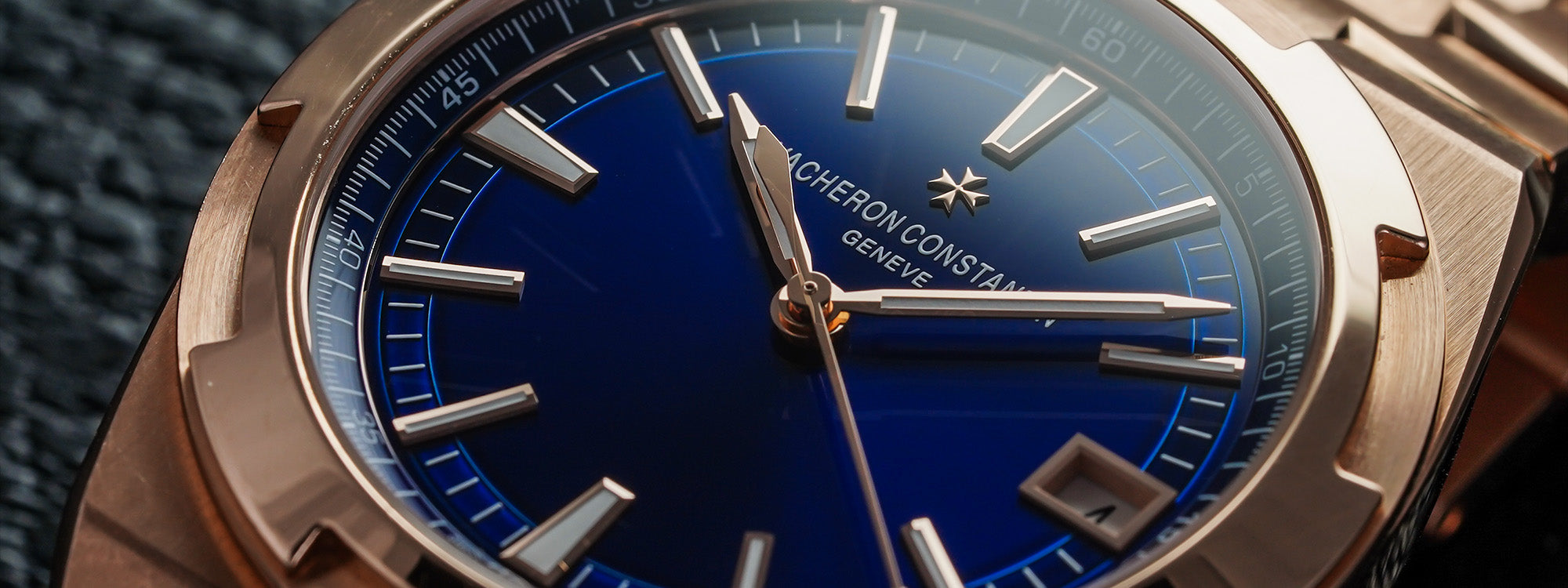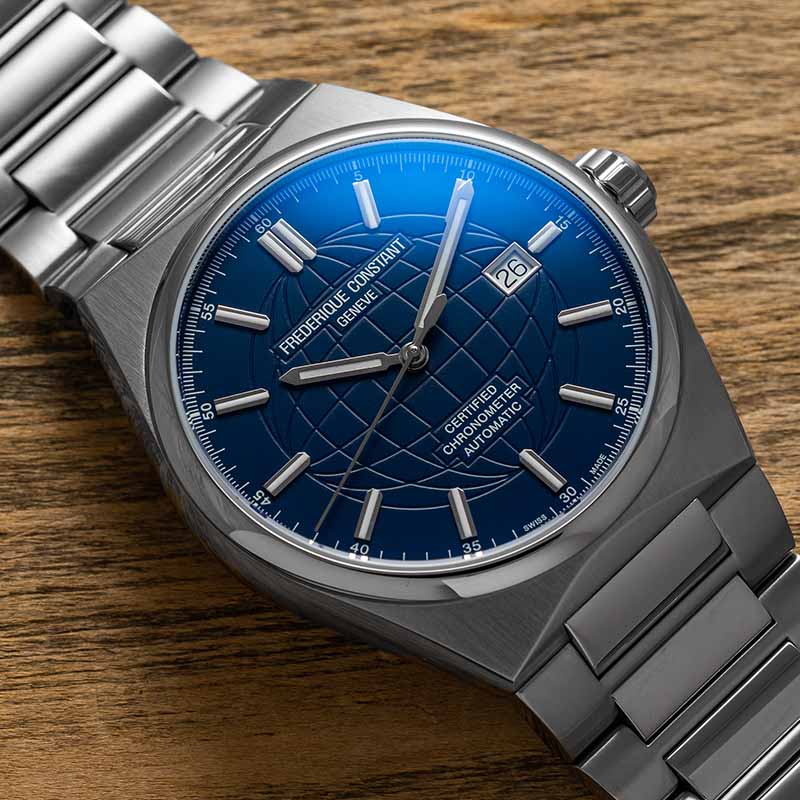The Vacheron Constantin Overseas has been a major pillar of the Swiss maison’s collection since its high-profile revamp in 2016, but its roots stretch back much further, drawing elements of its distinctive design from the mechanical-watch revival of the late 1990s, the embryonic sport-luxury era of the 1970s, and even as far back as 1880, the origin of Vacheron’s Maltese Cross emblem.
One of the oldest continuously operating watch manufacturers on the planet, Vacheron Constantin laid its foundation in 1755, more than a decade before the United States, eventually one of its most important markets, was even a country. Established as a watchmaking workshop by 24-year-old watchmaker Jean-Marc Vacheron, the company took on its current name when the founder’s grandson, Jacques-Barthemi Vacheron, partnered with businessman Francois Constantin. Over its first two centuries-plus in existence, Vacheron Constantin gained renown as an innovator of horological complications and a pioneer in design, as well as a watchmaker to royalty, including Egypt’s King Fuad I, who famously commissioned one of the world’s most complicated pocket watches (and also, for a time, the most expensive watch in the world sold at auction).
The OG of Overseas: Vacheron Constantin 222

Historiques Revival 222 in gold
In 1977, Vacheron Constantin commemorated its 220th anniversary of watchmaking with a boldly different and now highly collectible timepiece that helped lay the foundation for what we now call the “sport-luxury” watch style and also planted the seed for the modern Overseas collection. Five years earlier, another prestigious and historical Swiss watchmaker, Audemars Piguet, had introduced the Royal Oak, a game-changer for both the brand and the industry with, boldly offbeat elements including an integrated bracelet, octagonal bezel, textured dial, and visible screws. One year prior, Patek Philippe — then, as now, poised at the highest echelon of horological cred — released its own steel-cased, bracelet-mounted sports watch, the Nautilus. Vacheron Constantin must have been paying attention, both to the radical designs of these pieces and to the stir they were causing among watch enthusiasts, because the watch the venerable Genevan maker unveiled for its anniversary year may have been even odder at the time than those predecessors.
The Vacheron Constantin 222 (Ref. 44018) was notable for its monobloc steel case, scalloped, screw-down bezel, and an integrated steel bracelet with hexagonal center links. It also contained the same self-winding movement inside both the original Royal oak and Nautilus, the Jaeger-LeCoultre-derived Caliber 920, which helped to ensure an uncommonly thin case: 7.2mm thick for a somewhat large (at the time) 37mm diameter. At 5 o’clock on the corner of the case was another small but eventually key element: an inlaid Maltese cross, which Vacheron Constantin adopted as its emblem way back in 1880 thanks to its resemblance to a mechanism that regulated mainspring tension in a movement.

Only about 500 pieces were ever made of the so-called “Triple Two” model — most of them in steel, a few in bimetal steel-and-gold — before production was discontinued in 1985. Because it shared some obvious stylistic similarities with the Royal Oak and Nautilus, many believed for quite a while that the 222 was designed by the same icon behind the latter two models, Gérald Genta. But it was actually another prolific watch designer, Jorg Hysek, who’d imagineered Vacheron’s piece. Also like those two Genta-designed models, it struggled at first to find a receptive audience, and unlike those models, its manufacturer chose not to ride out the rough times with the 222. (It did, however, follow it up with a couple of now-obscure, short-lived successors, like the 333 and the Phidias.) Vacheron Constantin more or less retired the style for the next decade or so, but it would prove to be somewhat ahead of its time.
Overseas History: 1996 - 2016

In 1996, with the quartz crisis on the wane and a new mechanical-watch renaissance just over the horizon, Vacheron Constantin joined the Richemont Group of luxury companies, along with a host of other revered luxury watchmakers including Cartier, Jaeger-LeCoultre, IWC, and Panerai. That same year, the company under its new leadership decided to take another swing at the sport-luxury watch market, which was once again showing signs of energy and market enthusiasm.
The “disruptive” model that the company introduced that year, spearheaded by the design team of Vincent Kaufmann and Dino Modolo, replicated the 37mm size of the Triple Two but replaced its scalloped “bottle cap” bezel with an eight-sided one that was even more visually reminiscent of the Maltese cross. The watch was called “Overseas,” evoking the romance of travel and seafaring adventure, and its “Phase One” version housed a Girard-Perregaux automatic caliber and incorporated a sleek but relatively pedestrian three-link bracelet.

“Phase Two” of the Overseas made its debut in 2004, distinguished by an all-new, much more individualistic bracelet design that cleverly extended the Maltese Cross motif of the bezel. The bracelet’s links were now shaped like half-Maltese crosses, with the center link seamlessly integrating directly into the bezel. Even the buckle and the crown had been redesigned to evoke the brand’s universally recognizable emblem. Also distinguishing the second-generation Overseas were a new dial texture and a new, larger size — 42mm, a more robust silhouette in keeping with the ethos of the era, in which larger, more defiantly masculine timepieces were very much in vogue. The original three-hand-date (“Self Winding”) model and chronograph Overseas models were joined in short order by other complicated pieces, including the first Dual-Times and perpetual calendars.

The most recent revamp of the Vacheron Constantin Overseas, in 2016, brought another round of changes and upgrades that remain key to the collection today. The core Self-Winding model’s overall dimensions were whittled down to a slightly more restrained level — 41 mm, down from 42 mm, and a relatively slender 11mm thick. The eight-sided bezel was reworked to a more streamlined, six-sided design — thus putting some aesthetic distance between the Overseas and the famous peers from AP and Patek to which it has consistently been compared, both of which are notable for their octagonal bezels. Perhaps most significantly — and some might say overdue for a historical watchmaker prized for its in-house horological expertise — these “Phase Three” Overseas are the first to be equipped with Vacheron Constantin manufacture movements.

The automatic Caliber 5100, with a 60-hour power reserve, and the column-wheel-chronograph Caliber 5200, with a slightly reduced but still above-average 52-hour power reserve, were the first, ushering in additional versions in subsequent line extensions of the Overseas. The movements are on display behind clear sapphire casebacks, allowing a view of their primary aesthetic flourish, a solid 22K gold rotor with an engraved image of a compass wind rose, a classic nautical element that drives home the “Overseas” theme. Like the vast majority of Vacheron Constantin’s in-house movements, those inside the Overseas models bear the prestigious Geneva Hallmark, a sign of quality craftsmanship and elite decoration recognized throughout the Swiss watch industry.
The most “modern” aspect of the current Overseas collection, and one of the keys to its success, is the proprietary “easy-fit” interchangeable strap-and-bracelet system, introduced in the first models in 2016, which allows wearers to switch between bracelet and strap options without any tools, simply by twisting the bracelet by 180 degrees through the lugs. Such user-friendly strap and bracelet designs have proliferated among many luxury watchmakers in the years since, to the point where they are almost expected, but it was ultra-traditional Vacheron Constantin, of all brands, that was among the first to adopt this very fashion-oriented philosophy for its watches. All of these elements, classical and avant-garde, have combined for a very successful formula, as the Vacheron Constantin Overseas has become one of the undisputed leaders of the revived, integrated-sport-luxury-watch trend that shows no signs of abating as the watch industry forges into the third decade of the 21st Century. Here is a look at the current Overseas collection.
Overseas Self-Winding

The core of the expanding Overseas collection is still the Overseas Self-Winding, with the aforementioned in-house Caliber 5100 ticking inside a 41mm case and with bracelets and straps boasting Vacheron's "easy-fit" system. The cases, in steel or pink gold, are 10.6mm high and water-resistant to 150 meters. The dials are lacquered with satin finished centers and velvet-finished minute tracks; applied, lumed hour markers; and a framed date window at 3 o’clock. In addition to the 41mm models, Vacheron Constantin also offers smaller (34.5mm to 35mm) versions of the Overseas Self Winding, outfitted with the automatic Caliber 1088/1, as well as a handful of Overseas Quartz editions at an even smaller 33mm, many with diamond settings.
Overseas Chronograph

The Phase Three version of the Overseas Chronograph made its debut in the collection alongside the Self-Winding and the handful of other ground-floor models in the seminal “revival” year of 2016. Several iterations of the model have joined the family since, in stainless steel and pink gold, including a crowd-pleasing “panda dial” model that dropped in 2023. The watch has a silver sunburst dial, black velvet-finished subdials, and a black minute track on the dial’s periphery.
The 42.5mm steel case is a relatively modest 12.5mm thick and topped by the hallmark six-sided, Maltese-cross-inspired bezel. Inside is the self-winding Caliber 5200, boasting a host of high-horology finishes befitting its Geneva Hallmark, with an integrated chronograph function driven by a column wheel and vertical-clutch system. Mounted on either a rubber strap or a steel bracelet with the same Maltese-cross motif defining its shaped links, the watch tallies 30 elapsed minutes at 3 o’clock and 12 elapsed hours at 6 o’clock, while displaying the running seconds at 9 o’clock and the date at 4:30.
Overseas Dual Time

Despite the collection’s name, which conjures up images of crossing seas and oceans to reach exotic destinations, Vacheron Constantin waited until 2018 to introduce a travel-oriented dual-time complication to its sport-luxury family. The case, in steel or pink gold, matches the diameter of the Self-Winding model, at 41mm, and is just a smidgen thicker, at 12mm. The distinctive hexagonal bezel frames a lacquered dial with a velvet-textured flange and a sunburst-finished center (with color options including blue, black, silver, or dark green).
The dial’s center-mounted, red-tipped GMT hand indicates the home or reference time on the same ring of 12-hour indexes as the hour and minute hand for the local time and is linked to an AM/PM indicator at 9 o’clock with a small analog hand. At 6 o’clock, another small analog hand points to the date on a 31-day subdial. All of these indications come courtesy of the manufacture Caliber 5110 DT, a descendant of the self-winding Caliber 5100 boasting the same 60-hour power reserve.
Overseas World Time

Taking a step up in complexity is another timepiece for frequent travelers, the Overseas World Time, which is the first Overseas equipped with Vacheron’s innovative Caliber 2460WT, which debuted in a Patrimony model in 2011 and was one of the first, and still very few, whose world-time function could display the time in all 37 world time zones rather than the 24 based around the Greenwich Meridian (GMT).
The dial framed by the case’s multifaceted bezel features a polar map with satin-sunburst continents and velvet-finished oceans, along with a lacquered city ring. In a unique and inspired take on the traditional day/night indication, a sapphire disk above the globe disk, reveals AM and PM in the various time zones with its smoky, shaded tints. This version of the movement has the gold rotor with the engraved wind rose emblem that serves as a symbol of the Overseas collection.
Overseas Moon Phase Retrograde Date

Launched in 2023, the latest complication from the manufacture’s sport-luxury Overseas collection features not only a high-precision moon-phase display but also the first retrograde function in a Vacheron Constantin sports watch. Devoted to revealing the date on an arc-shaped 31-day scale, the small hand positioned over the moon-phase aperture at 6 o’clock jumps back to Day One at the end of each month. The 41mm steel case has the hallmark six-sided bezel and a fluted screw-down crown that also bears a Maltese cross motif.
The blue lacquered dial with sword hour and minute hands has a satin-finished center and a velvet-finished flange. Yet another in-house movement, Caliber 2460 R31L/2, beats inside, amassing a 40-hour power reserve with its engraved 22k gold oscillating weight and directing the ultra-accurate moon-phase indication; the revolutions of the lunar disk corresponds to the actual cycle of the moon, which rotates around the Earth once every 29 days, 12 hours, and 45 minutes.
Overseas Perpetual Calendar Ultra-Thin

The Overseas Perpetual Calendar Ultra-Thin was the high-complication pinnacle of the original 2016 lineup and remains a mainstay of the collection today, offering a model in either and in pink or white gold. The timepiece earns its “Ultra Thin” epithet with a 41.5mm case that measures just 8.1mm thick — yes, that’s thinner than the far simpler Self Winding version, despite the addition of calendar displays. The lacquered dial features an analog date at 3 o’clock; a moon-phase at 6 o’clock; an analog day indicator at 9 o’clock; and an unusual, integrated four-year month counter at 12 o’clock that tracks the leap year without adding an additional indicator for it.
Behind the complex dial beats Vacheron’s manufacture Caliber 1120 QP/1, with a 40-hour power reserve, an array of haute horlogerie finishes, and a skeletonized version of the 22k-gold, wind-rose rotor. In keeping with the ethos of the contemporary Overseas series, the watch has an easily customizable construction with a gold bracelet, blue alligator strap, and blue rubber strap all included.
Overseas Tourbillon

The first tourbillon timepiece in the Overseas collection made its debut in 2019, further expanding the range of high-horology options in the sport-luxury family. The first version, interestingly, was in stainless steel, with subsequent editions in pink gold and titanium, with a case size of 42.5mm wide (matching the dimensions of the Chronograph) and 10.39mm thick. The in-house movement inside is noteworthy for its use of a peripheral rotor for its automatic winding system, which ensures that the rotor never blocks the view of the large tourbillon regulator at 6 o’clock. Here again, Vacheron’s designers have incorporated the Overseas’ guiding motif in a clever and utilitarian way: the tourbillon cage, which rotates on its axis every 60 seconds, has been crafted in the shape of a Maltese cross. The movement also amasses a power reserve of 80 hours, or a full three days, which is unusual for a tourbillon.
Overseas Perpetual Calendar Ultra Thin Skeleton

In 2020, Vacheron Constantin took its first deep dive into skeletonization for its most horologically complex Overseas models. First up was the Perpetual Calendar Ultra-Thin Skeleton, for which the maison’s watchmakers meticulously stripped down the automatic Caliber 1120 QP/1 to its essentials and replaced the solid-gold wind-rose rotor with a black NAC-treated oscillating mass with an elegant cutout of (you guessed it) the Vacheron Maltese cross. The main dial is made of sapphire, with four white openworked subdials for the various calendar indications in a perfectly balanced cloverleaf design. Its case is 41mm in diameter and a very svelte 8.1mm thick, and available in pink or white gold; behind the golden hands, applied indexes, and calendar subdials, the movement’s ornate engravings, straight-grained and beveled edges, circular and sun-brushed treatments are on display for a breathtaking miniature vista.
Overseas Tourbillon Skeleton

Following the Perpetual Calendar Skeleton in 2022 was the Overseas Tourbillon Skeleton, which represented several firsts for Vacheron Constantin: it was the first skeletonized tourbillon in the Overseas collection, the first watch from the maison to use titanium for all of its major exterior parts — case, bezel, crown, and bracelet — and the first to use a new balance spring with a Breguet overcoil. The 42.5mm case is made from either Grade 5 titanium, as noted above, or 18k pink gold, and houses a painstakingly openworked version of the self-winding Caliber 2160 developed for the original Overseas Tourbillon (here renamed Caliber 2160 SQ). The skeletonization reduced the movement’s weight by a full 20 percent and resulted in an almost unthinkable thinness of 5.65mm, considering the presence of a tourbillon carriage.
Thanks to the transparent sapphire dial and the sapphire exhibition caseback, the movement’s high-horology decorations are in easy view, including the anthracite-toned NAC treatment on the baseplate and bridges as well as on the barrel, which stores a three-day power reserve generated by the peripheral rotor. The latter feature has had its drum and cover entirety openworked to resemble the familiar compass rose emblem of the collection, an aesthetically on-theme element that joins the Maltese-cross-shaped tourbillon at 6 o’clock to set this horological chef d’oeuvre apart from its siblings in the Overseas family.
Return of the Inspiration: Vacheron Constantin Historiques 222

It’s not technically part of the Overseas collection, but I’d be remiss not to mention the return, in 2022, of the timepiece that provided the earliest inspiration for it. To create the Historiques 222 — it’s the first Historiques model with a numeral in its name that doesn’t refer to a year — Vacheron Constantin replicated the original “Triple Two”: Ref. 44018 in 3NN yellow gold, in nearly every respect: the diameter of the case, the integrated bracelet, and the gold-toned dial with baton-shaped hands and applied hour markers. Even the green-glowing Super-LumiNova on the hands and markers was chosen to match the hue of the tritium used on the historical model’s dial.
There are a handful of differing elements — like increased ergonomics for the bracelet, a more legible placement of the date window, and a slightly thicker case profile, with an exhibition caseback — but the most significant upgrade is the new in-house Caliber 2455/2, with a new yellow-gold rotor enhanced with the original “222” logo. The original Historiques 222, in yellow gold, was one of the surprise hits of Watches & Wonders 2022, and the inevitable and long-awaited steel version followed in 2025 as one of several special releases for Vacheron Constantin’s milestone 270th anniversary. You can learn more at vacheron-constantin.com






















































0 Comments